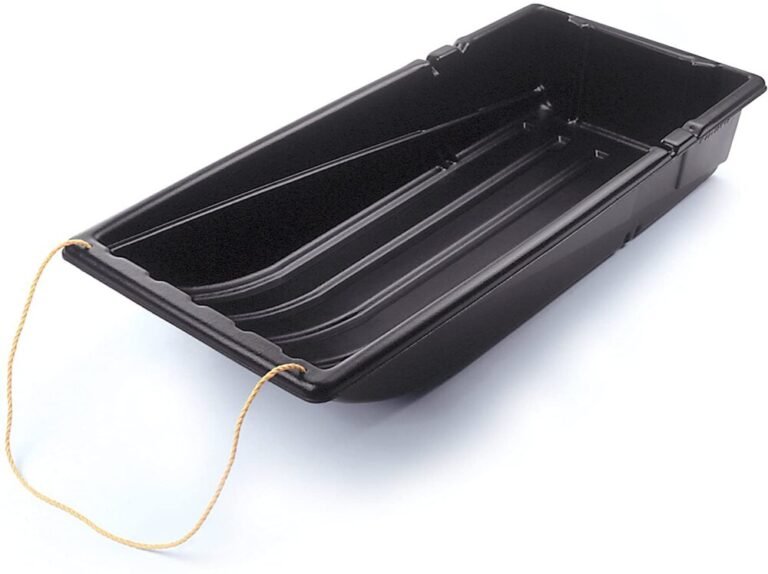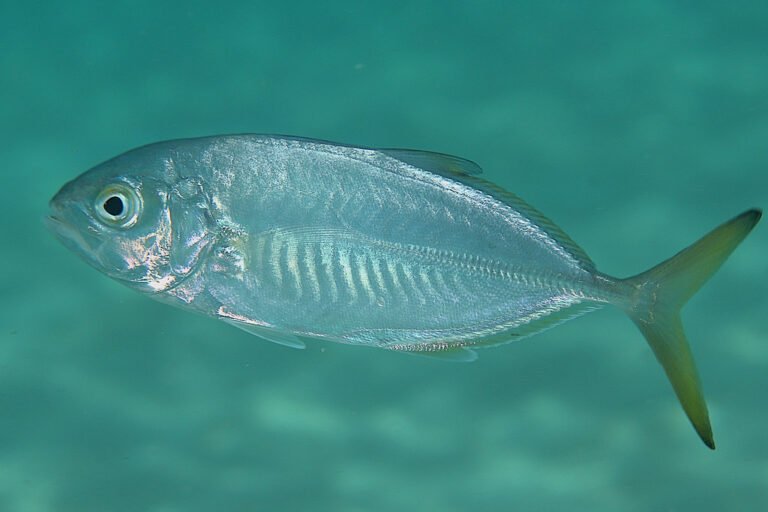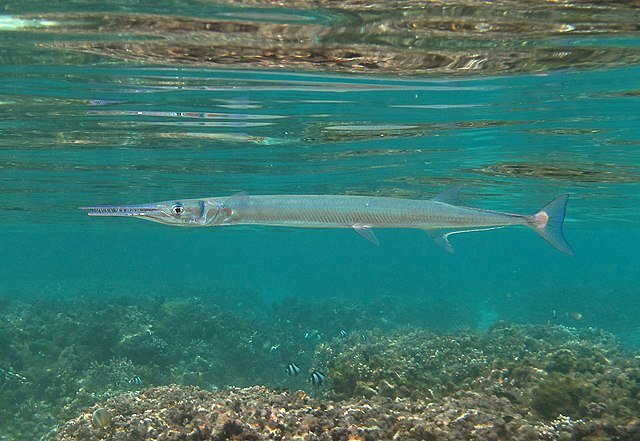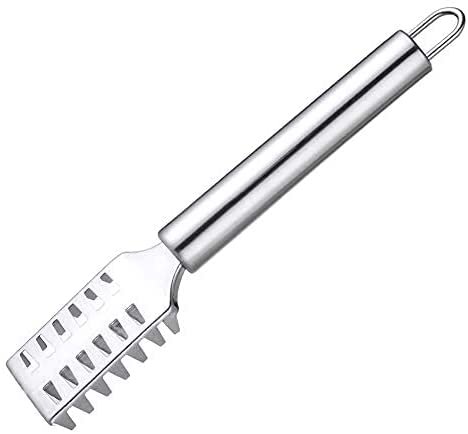What Is Redfish and What Does It Taste Like?
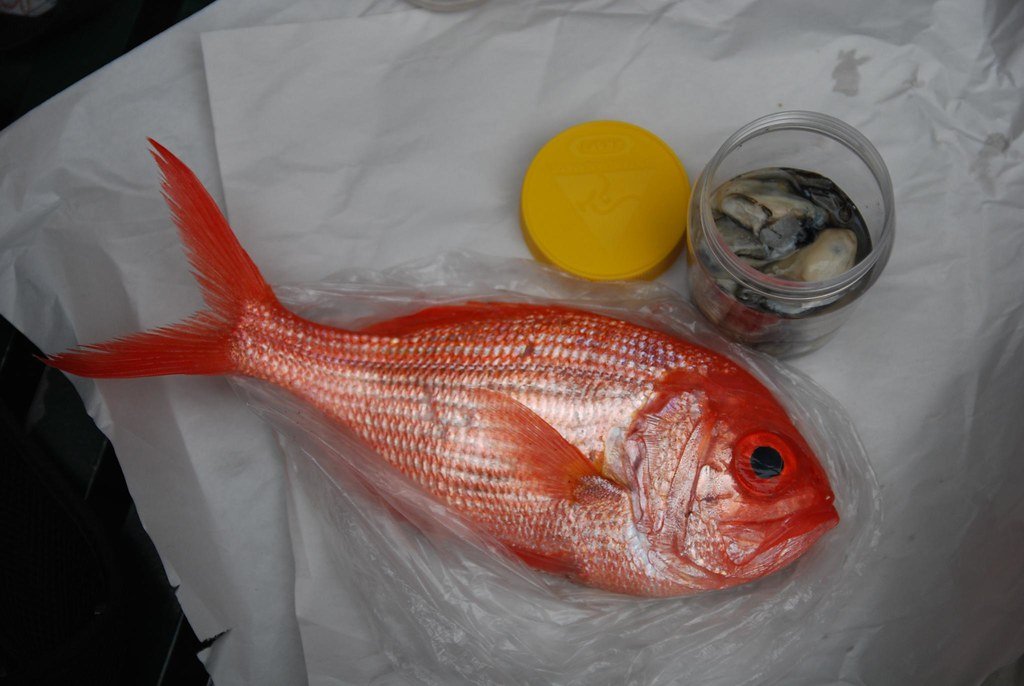
What Is Redfish?
Redfish is a common name for several different fish species. The Redfish, also known as red drum, channel bass, spot tail bass, puppy drum, or just red, is a popular (inshore) game fish naturally found along the Gulf Coast and Atlantic Ocean.
Redfish are a schooling species, can typically reach between 12 and 14 inches in length in their first year, and may live more than 40 years old. Some exceed 50 pounds (22.68 kg) in weight, with the world record currently capped at 94 Pounds (42.64 kg) (Whew!).
They’re famous seafood and are popularly used as bait to catch lobsters. They have a characteristic black spot (eyespot), close to the upper part of their tail base.
It is believed by scientists that the black spot around the redfish’s tail helps it trick predators into attacking the tail, instead of the head of the fish, thereby giving the redfish room to escape.
They’re one of the most sought-after recreational fishes on the Gulf Coast. Typically inhabiting shallow waters beside bay edges has lots of vegetation, but they can also live just fine in freshwater.
They seem to also be attracted to locations with lots of soft mud and submerged vegetation. The name “Drum Fish” comes from the drum-like sound they make when they’re pulled out of the water or during courtship.
Types and Species of Redfish
- Redfish (Centroberyx affinis)
- Red Snapper (Lutjanus campechanus)
- Red Drum (Sciaenops ocellatus)
- Rose Fish (Sebastes norvegicus)
- Acadian Redfish (Sebastes fasciatus)
- Blackfin Snapper (Lutjanus buccanella)
- Queen Snapper (Etelis oculatus)
- Crimson Snapper (Lutjanus erythropterus)
- Malabar Blood Snapper (Lutjanus malabaricus)
- Southern Red Snapper (Lutjanus purpureus)
- Emperor Red Snapper (Lutjanus sebae)
- Lane Snapper (Lutjanus synagris)
- Sockeye Salmon (Oncorhynchus nerka)
- Vermillion Snapper (Rhomboplites aurorubens)
- Deepwater Redfish (Sebastes mentella)
- Norway Redfish (Sebastes viviparus)
What Do Redfish Eat?
Before we get into answering what they taste like, or if we should, in fact, eat them, we are going to talk a little bit about what they eat.
They are ravenous feeders (gluttonous bottom feeders that would eat any living thing they can), that would consume live baitfish (yep, your own fish), shellfish, shrimps, crabs, small mullets, minnows, etc.
What Does Redfish Taste Like?
Now that we’ve discussed a little bit about what a redfish is and what they eat, you might wonder what they taste like and if they’re even safe to eat (I mean, no one wants to start growing a mysterious black spot on their butt after eating a channel bass, right?).
Red drums are not oily (they’re low in saturated fat), and they have a moderate flavor. Smaller ones under 10 to 15 pounds (4.54 kg to 6.80 kg) are tastier.
They have a mild, slightly sweet flavor with a medium-firm (and flaky) texture. They’re typically coated with black seasoning and pan-fried/grilled (Yum!).
Can You Eat Redfish? (Are Redfish Good To Eat?)
The simple answer is Yes, BUT it is only safe to eat as long as it’s properly cooked and you probably should focus on redfish smaller than 24 inches or thereabout.
Unlike sushi, this fish isn’t to be eaten raw as there’s a high probability it contains parasites that can cause a lot of problems (this is why it must be cooked thoroughly before eating).
These fish are very popular among anglers in the southeast and they cook up snowy white. They’re a good source of phosphorus, selenium, protein, calcium, vitamins B12, vitamins B6, and niacin. Learn about gertrudes fishes, and what they taste like.
What Is A Red Snapper, and What Does a Red Snapper Taste Like?
Red snappers are red in color and are termed snappers because of their animal-like teeth. They’re pretty easy to distinguish because of their bright reddish, pinkish hue. When they develop and grow larger, the red color becomes deeper and their eyes would also be red.
They can grow up to 35 pounds (15.89 kg) in weight. They have medium to large scales and spiny dorsal fins. They’re caught commercially as well as for recreation. What is the best fishing chair? Find out here.
What Does a Red Snapper Taste Like?
For real, what do these things taste like?! Guess we’ll never know, ha just kidding, we’re about to give you an insight into what Red Snappers taste like, so sit tight and get your taste buds fishing!
Red Snappers are moist with a mild, sweet nutty flavor and a firm but delicate texture. They are low-calorie, protein, and selenium-rich seafood. They’re also rich in omega-3 fatty acids, potassium, and vitamin A.
Their raw flesh is pinkish in color with yellow streaks that turn lighter when cooked. They can be pan-fried, steamed, broiled, grilled, deep-fried, or baked.
They may contain mercury which can be harmful to young children and pregnant women. Although pregnant women and children can eat this type of fish just fine, they should limit their consumption to only a very few times a month.
Redfish vs. Red Snapper
Now a redfish can be confused for red snapper, because, well for one, they both start with the word “red”. They both definitely look different and live different life cycles.
Each species lives in a different habitat and manner, but they both share a similar history of crisis and recovery along the Gulf Coast.
In the early 1980s to 1990s, these two fishes were extensively overfished up to near extinction (Sheesh, is it a crime to be a fish that tastes good).
Commonly living in depths of 100 to 200 ft, the red snapper is mainly found along Florida and North Carolina, in North America. They’re pretty easy to distinguish because of their bright reddish, pinkish hue.
When they develop and grow larger, the red color becomes deeper and their eyes also become red (creepy stuff to see at night lol).
On the other hand, a redfish is commonly found along the Atlantic Ocean and on the Gulf Coast. They have a black spot near their tail base are white in color around their belly (lower half) and have a bronze color on their upper half.
Norway Redfish (Sebastes viviparus)
The Sebastes viviparous, belonging to the family Sebastidae, is popularly known as the Norway redfish. It is commonly found along the coasts of the northern Atlantic Ocean.
Deepwater Redfish (Sebastes mentella)
The Deepwater redfish is also popularly referred to as ocean perch, golden redfish, and Atlantic redfish. They are typically less than the 45 cm (18 inches) size range but can grow to between 55 cm to 70 cm (22 inches to 28 inches).
You can find them in large volumes in the North Atlantic. They feed on a variety of seafood, e.g. small fish. They’ve internal fertilization and spawn living larvae. The Deepwater redfish looks very much like the Acadian redfish.
Northern Red Snapper (Lutjanus Campechanus)
Native to the western Atlantic Ocean, the Caribbean Sea, and the Gulf of Mexico, the northern red snapper belongs to the species of marine ray-finned fish as well. They’re a rather large and red-colored, well sought-after game fish, having short needle-like teeth, and serve commercial purposes as well.
The maximum recorded length is about 39 inches (100 cm), the max published weight is about 22.29 kg (50 pounds and 4 oz), and the oldest reported age dates 100+ years (Woow, a fish as old as granny). They don’t have a single preferred habitat, their preference changes as they grow and mature.
They’re light red in color, with a more intense coloration on their backs. This gregarious species forms large schools around wrecks and reefs with fish of like size.
Crimson Snapper (Lutjanus erythropterus)
Commonly found in the Pacific and Indian Oceans, the crimson snapper is a predominantly nocturnal hunter, belonging to the species of marine ray-finned fish. It’s also popularly referred to as the crimson sea perch, the smallmouth nannygai, the red bream, and the high-brow sea perch.
It’s on record that they have a max lifespan of about 42 years of age, and spawn across the year in Indonesia and Australia. The adults are typically pinkish-red to silver in color, and they feed on cephalopods (such as small squids, octopuses, etc.), and crustaceans.
The typical length is about 18 inches (45 cm), but the maximum recorded length for this species is about 32.1 inches (81.6 cm)
Sockeye Salmon (Oncorhynchus Nerka)
The sockeye salmon is also popularly termed kokanee salmon, or blueback salmon (due to its color). They’re an anadromous species (they migrate up rivers from the sea to spawn). Their diet consists mainly of zooplankton. Sockeye salmon are semelparous (that is, they die after they spawn).
They occur in the Eastern Pacific, Northern Hokkaidō Island in Japan, Bathurst Inlet in the Canadian Arctic and Anadyr River in Siberia. The sockeye salmon feed mainly on zooplankton, small organisms such as shrimps, and insects being part of the Juvenile’s diets.
They’re mainly red in hue when spawning. For this species, the females are responsible for parenting, and there’s typically a dramatic sexual dimorphism at maturity.
Rose Fish (Sebastes Norvegicus)
The Rose fish is also popularly known as the ocean perch and Norway haddock. They’re a slow-growing, late-maturing large fish. They’re commonly found along the coasts of northern Europe and eastern North America.
Emperor Red Snapper (Lutjanus Sebae)
The emperor red snapper, also popularly called king snapper, is characterized by a steeply sloped snout and also happens to belong to the species of marine ray-finned fish.
With a max length of 46 inches (116 cm), and a max published weight being 72 pounds (32.7 kg), the emperor red snapper has an overall reddish to pink color and is commonly found in the Indo-Pacific region, Eastern Africa, Pacific Ocean, New Caledonia, Australia, and Japan.
This species inhabits both coral reefs and rocky areas. They’re predatory fish and feed on fishes, benthic crustaceans, and cephalopods. This is a slow-growing species. They typically move in schools with like-sized fishes or they move alone. They can live up to 40 years of age.
Vermilion Snapper (Rhomboplites Aurorubens)
The vermilion snapper also commonly termed the clubhead snapper and night snapper belongs to the species of marine ray-finned fish as well.
They’re native to the western Atlantic Ocean and also occur in North Carolina, Bahamas, Bermuda, the Gulf of Mexico, the Caribbean Sea, and Santa Catarina, Brazil, and possess a short snout and an elongated oblong body.
They typically move in large schools, and spawning spans the whole year. They’re a slow-growing fish that feeds on small fishes, shrimps, crabs, cephalopods, and other invertebrates.
Southern Red Snapper (Lutjanus Purpureus)
The southern red snapper or Caribbean red snapper is characterized by having a large eye, a weakly developed incision, and a blunt short snout, having simple holes for nostrils. They spawn during summer and spring and have an estimated life span of 12 – 18 years, and belong to the species of marine ray-finned fish.
They’re predatory with their diet consisting of shrimps, fish, crabs, and cephalopods. Having on record a max length of 39 inches (100 cm), and a max published weight of about 22 pounds (10 kg), this fish is commonly found in the western Atlantic Ocean and throughout the Caribbean Sea.
Malabar Blood Snapper (Lutjanus Malabaricus)
Found to commonly occur in Southern Japan, Indo-West Pacific, Australia, Fiji, Indian Ocean, South Korea, Tonga, and Kosrae, the Malabar Blood Snapper, like the Crimson snapper, are also predominantly nocturnal hunters belonging to the species of marine ray-finned fish.
Its larger head and mouth serve as a major differentiating factor for it from the scarlet snapper fish. It is also popularly termed saddle tail snapper, large-mouthed sea perch, or scarlet emperor. Although typically being about 20 inches (50 cm) in length, this fish does set a record of max length at about 39 inches (100 cm), and a max published weight of about 17 pounds (7.9 kg).
Juveniles have been seen to prefer shallow waters near the shores, but adults prefer deeper areas and typically occur in coastal and offshore reefs. Like the crimson snapper, they feed on cephalopods (such as small squids, octopuses, etc.), crustaceans, and benthic invertebrates (seafloor creatures without vertebrae (i.e. a backbone)).
Acadian Redfish (Sebastes Fasciatus)
The Acadian redfish, also popularly referred to as the Acadian rockfish and Labrador redfish belongs to the species of marine deep-water fish. They can live up to 50 years of age and can reach up to 20 inches (50.8 cm) in length.
Reddish-orange in color and native to the northwestern Atlantic Ocean, western Greenland, Virginia, the Gulf of St. Lawrence, Nova Scotia, and Iceland, they’re ovoviviparous (producing young by means of eggs which are hatched within the body of the parent), and spawn during fall into late winter. They feed on a plethora of foods, some of which include crustaceans, mollusks, and smaller fishes.
Blackfin Snapper (Lutjanus Buccanella)
The blackfin snapper, also popularly known as the blackfin red snapper and the blackspot snapper, belongs to the species of marine ray-finned fish and is commonly found in the western Atlantic Ocean, Bahamas, Gulf of Mexico, Northern Yucatan Peninsula, Bermuda, North Carolina, Cuba, Caribbean Sea, South American Coast, and Sao Paulo, Brazil.
They’re opportunistic sea bed predatory feeders that feed on small fishes, shrimps, worms, etc. They also accumulate in small schools as they’re a social species. The blackfin snappers have been recorded to spawn throughout the year, with peaks around April and September. The max length recorded for this fish is about 30 inches (75 cm), and the maximum published weight is about 30.9 pounds (14.0 kg).
Queen Snapper (Etelis Oculatus)
The queen snapper, a bathydemersal fish (a demersed fish living/feeding underwater below 200m (650 ft)), also popularly referred to as the night snapper or brim snapper belongs to the species of ray-finned fish. It is native to the western Atlantic Ocean and is the only species of its genus found outside the Indo-Pacific region.
Having an elongated, and slender body, this fish is characterized by yellow large eyes a red iris, and a short snout. Its occurrence also extends to the Gulf of Mexico, Bermuda, North Carolina, Fernando de Noronha, and Atol das Rocas Islands of Brazil, the Atlantic Coast of the United States, the Caribbean Sea, and São Paulo in Brazil.
Lane Snapper (Lutjanus Synagris)
The lane snapper also popularly called the Mexican snapper or spot snapper belongs to the species of marine ray-finned fish. It has a sharply pointed snout and an oblong and compressed body. The lane snapper has a max recorded length of about 24 inches (60 cm), and a max published weight coming in at around 7.7 pounds (3.5 kg).
Found commonly in the Western Atlantic Ocean, Caribbean Sea, Gulf of Mexico, North Carolina, Bermuda, Santa Catarina, and Brazil, the Mexican snappers are nocturnal and opportunistic predators that consume different animals. They typically feed on crustaceans, cephalopods, and smaller fishes.
The Best Redfish Lures (What Is The Best Bait For Redfish?)
How To Catch Redfish (Red Drum) (Fishing Tips For Inshore Shallow Water)
How To Cook Red Drum & Grill Redfish
Grilled Redfish On The Half Shell Recipe (From BBQGuys.com)
The Marinade (Optional):
- 1/4 cup- Worcestershire sauce
- 1/4 cup of extra virgin olive oil
- 1/4 – 1/2 Teaspoon- cayenne pepper
- 1/4 teaspoon- dried thyme
- 1 Tablespoon- paprika (You can also add fresh ground pepper and some sea salt to up that taste)
- 1 yellow onion
- 1 lemon
- 2 whole garlic cloves
- 1 bunch – parsley
- 1/2 stick (unsalted/diced)- butter
Grilling Process:
- Lay the redfish fillets in a bowl flesh with their sides up.
- Pour the marinade ingredients over the fillets, and rub them well. Once done, set it aside.
- Slice the garlic, onion, and half a lemon (thin slices).
- Squeeze the reserved other half of the lemon on top of the fish.
- Lay the thin sliced onion and garlic over the fish and allow to marinade for about 30 minutes.
- Next, you need to preheat your grill to medium heat and then put the fillets on the grill with their fleshy side down.
- Once the fleshy side has obtained a nice color and grill marks are obvious, turn the fillet’s fleshy side up, and add the onion and garlic slices you kept from earlier.
- Once the fish has cooked for about 20 minutes, place a cast iron saucepan on the grill.
- Add in butter, once it is halfway melted remove the pan from the grill and add parsley.
- Season sauce with some sea salt to up the taste and a squeeze of lemon of course.
- Remove the red drum from the grill and pour sauce over the top. You can also consider garnishing the top of the fillets with some thinly sliced lemons
Some More Amazing Red Drum Recipes Can Be Found Here: https://www.wikihow.com/Cook-Redfish
How To Cook Redfish
How To Fillet A Red Drum
When considering preparing, filleting them is one of the most popular options. Ensure you have a thin-bladed sharp knife handy, as a blunt knife would just end up making everything messy. Filleting this particular type of fish can be kind of difficult because they have really thick armored scales and tough rib bones.
- Gut The Fish: Insert the thin-bladed sharp knife between the pectoral fins of the fish, move the knife down to the vent, and open the body cavity. Remove and discard the guts.
- Put your knife just right behind the gills and you’re going to cut laterally across the body down to the anal tract.
- Turn the fish and make one long cut down the spine area (use the tip of your knife and don’t cut through the spine).
- Continue to use the tip of your knife to cut through till you’re done. We have provided this video to help better fillet than we can explain in words…
What Is A Bull Redfish?
A bull redfish is simply a redfish over 26″ (66 cm) in length.
What Does Haddock Taste Like?
Haddocks have a medium flaky texture (tender yet firm), lean white flesh, and a mildly sweet taste. They’re more flavorful and fishy than Cod.
What Does Walleye Taste Like?
They’re freshwater fish with beautiful fine-flaked fillets. With a firm, yet quite delicate texture, they have a subtle sweet flavor, a buttery mouthfeel, and a low level of fishiness.

